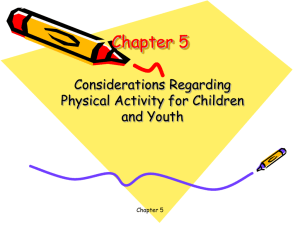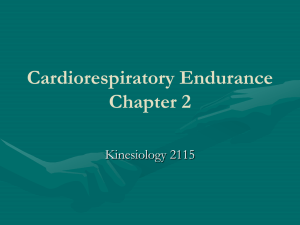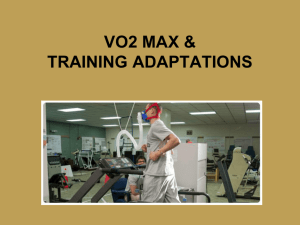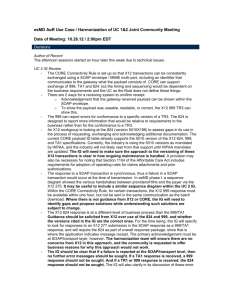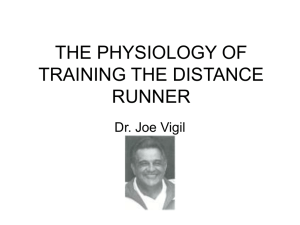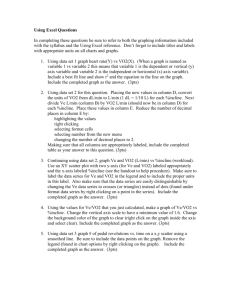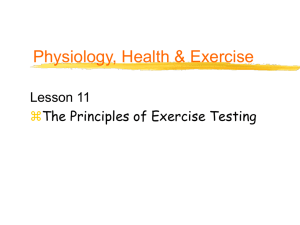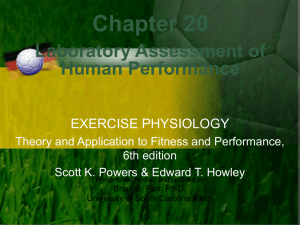Chapter 2 Slides
advertisement
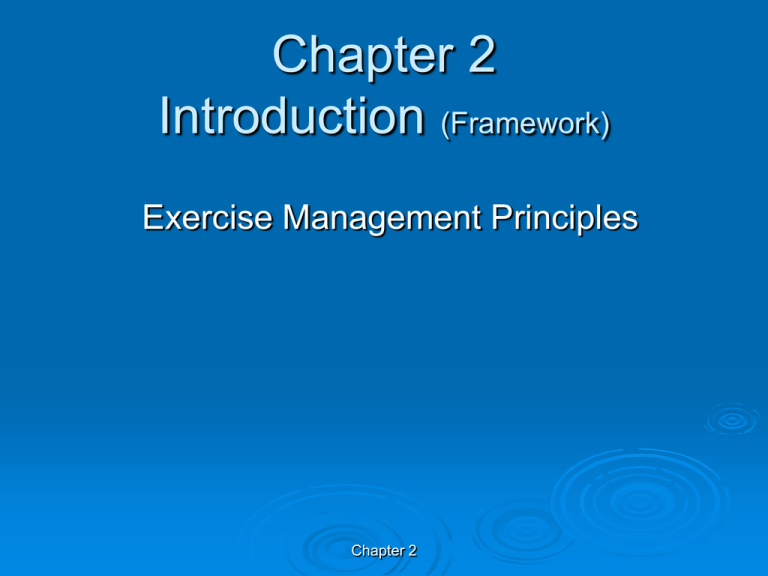
Chapter 2 Introduction (Framework) Exercise Management Principles Chapter 2 Exercise Management Principles Problem – Oriented Exercise Management Consists of Five Steps (SOAP) • S – Collection of Subjective Data • O – Collection of Objective Data • A – Assessment and Generation of a Problem List • P – Formulation of a Diagnostic and / or Therapeutic Plan • Follow-up – Periodic Reassessment Chapter 2 Exercise Management Principles (SOAP) S – Getting Subjective Data • Subjective history of physical activity and medical problems •What are the complaints and symptoms? •What are their perceived limitations? •Why does the subject want to exercise? •Why is their exercise history? •What are the current medications and medical treatment? Subjective assessment can help you to determine which type of exercise tests may be warranted. Chapter 2 Exercise Management Principles (SOAP) O – Getting Objective Data • Includes information gathered during medical / physical examinations and lab tests • Medical exams and lab tests can confirm or refute causes of symptoms and be used for diagnostic purposes. •Collected objective data may help to determine the types of exercise test(s) that may be helpful in prescribing an exercise program. (see families of exercise test types p.10, text) •The exercise test should be individualized to meet the special needs of each subject while allowing for the assessment required for designing an individualized exercise program. •Thus, the exercise leader will have to “estimate” the exercise capacity of the subject when selecting an exercise test protocol. Chapter 2 Exercise Management Principles (SOAP) A – Making the Assessment • Subjective and Objective Data collected can be used to determine specific types of problems that need to be addressed via exercise programming •Exercise testing may reveal additional underlying problems not determined during resting assessment, and/or confirm the presence of observed problems during the resting assessment •Several testing measurements may be required to fully address the underlying problem(s). Chapter 2 Exercise Management Principles (SOAP) P – Formulating a Plan • The plan of action is the path that will lead to diagnosis and treatment of the problem •Treatment of the problem will be addressed through the exercise prescription •The prescription musty have short and long term goals •The subject should understand the associated risks vs. the benefits of exercise programs. You should explain the risk vs. benefits of physical activity as it pertains to the individual health problem(s) of the subject. Chapter 2 Exercise Management Principles S.M.A.R.T. GOALS S: goals must be specific and clearly defined M: goals must use real endpoints to measure success (ex. 15% reduction in body fat) A: goals should be “Actionable”, something the individual truly believes and desires R: goals should be realistic T: goals should be time oriented Chapter 2 Exercise Management Principles Reassessment (follow-up) •You should have a reassessment plan in place to determine the effectiveness of the exercise program •Reassessment will determine the therapeutic effect of the exercise program •Reassessment should be scheduled when enough time has elapsed from the original assessment for the therapeutic effects of the exercise program to occur. •Reassessment will assist in determining the effectiveness of the exercise program, and if the exercise goals have been met. Chapter 2 Exercise Management Principles Families of Exercise Tests Measures Permit Evaluation for Exercise Prescription Families of Tests • Aerobic Exercise • Anaerobic Exercise • Endurance Exercise • Strength Exercise • Flexibility Exercise • Neuromuscular Exercise • Functional Performance Chapter 2 Exercise Management Principles Aerobic Exercise Test Terminology VO2 max – the maximum amount of oxygen utilized by the muscles during exercise. VO2 max is determined during a maximal exercise test. During a maximal exercise test the only limitation to further exercise performance should be oxygen delivery or uptake. Peak VO2 – is the highest rate of oxygen consumption measured during the exercise test, regardless of whether or not VO2 max is attained. peak VO2 maybe higher, lower, or equal to VO2 max.1 Chapter 2 Exercise Management Principles Aerobic Exercise Test Terminology VO2 MSS – the maximum sustainable speed (workload) that can be maintained (indefinitely) during an exercise test. Ramp Protocols – Graded exercise tests that are individualized and provide continuous, frequent (every 10-20 seconds) increments of work rate so that VO2 increases linearly.1 Chapter 2 Exercise Management Principles Aerobic Exercise Test Maximal Oxygen Consumption is important to determine but people with chronic disease and disability may have other limitations that disallow the measurement of maximal oxygen consumption Peak VO2 is usually assessed For persons with chronic disease and disability, the usual range of sustainable work (MSS) is 40 to 70% of their actual maximal oxygen consumption. Chapter 2 Exercise Management Principles Aerobic Exercise Test Ramp Protocols are preferred because VO2 can be assessed in a linear fashion, and signs / symptoms of disease can be determined at submaximal workloads. It is important to choose a ramp protocol that will allow the subject to complete the test in 8-10 minutes. Chapter 2 Exercise Management Principles Anaerobic Exercise Test Are used to determine maximum energy expenditure (high intensity work) in a short period of time The exercise intensity generated during an anaerobic test will meet or exceed that of the aerobic test. These types of tests are appropriate for athletes who are preparing for competition. Chapter 2 Exercise Management Principles Endurance Tests Are used to determine submaximal energy expenditure (high intensity work) over a longer period of time. Strength Tests Are used to determine the relative strength (or weakness) of a muscle or muscle group. Chapter 2 Exercise Management Principles Flexibility Tests Are used to determine range of movement within a joint or a series of joints in a segment. Neuromuscular Tests Are used to determine coordination and motor skill performance. Chapter 2 Exercise Management Principles Functional Performance Tests Designed to determine the capacity of a person to perform ADL (Activities of Daily Living). Functional performance tests should mimic real tasks. It is possible to assess physical functioning using a self-report questionnaire as a predictive model. Chapter 2 Exercise Management Principles No Exercise Test Sometimes exercise programs must be developed without exercise testing. Predictive exercise intensity equations (Heart Rate Reserve) or Scales (RPE) can be used to guide the intensity of the exercise session. If using a predictive equation, you should err on the “low” end of the estimate, then work towards a higher intensity of exercise, if warranted. RPE scales should be used when heart rate is not a good predictor of exercise intensity ( drugs that blunt heart rate response) Chapter 2 Exercise Management Principles Exercise Dose - Response Exercise prescription is both an art and a science The science is in the tests, measurements, collection, and analysis of exercise data The art is in fine tuning the exercise program to meet the individuals needs while observing their physical limitations. The exercise leader should help the patient develop reasonable exercise goals for exercise therapy Chapter 2 Exercise Management Principles Exercise Dose - Response The balance of Frequency, Intensity, Time, and Type of exercise should determine the rate of progress towards meeting the exercise goals Exercise progression (dose loads) depend upon the type of disease or disability the patient has, recovery time required, and upon their initial fitness or functional level. High doses of exercise increase the risk of exhaustion, and high frequency of exercise superimposes more training on incomplete recovery and risks overtraining. Chapter 2 Exercise Management Principles Risk, Cost, and Benefit Risk is the chance of something “bad” happening. Exercise involves two types of risk: • Disease-Dependent Risk Risks that are inherent because of the presence of the disease. • Activity Dependent Risk Risks that may occur ( injury) because of the participation in physical activity Chapter 2 Exercise Management Principles Risk, Cost, and Benefit The costs of physical activity include time, energy, and money put into the program. The benefits of an exercise program are usually focused on the improvements in quality of life, physical and/or functional performance, and the treatment / regression of disease and aging. Chapter 2 Exercise Management Principles End Note: please review the information on Exercise and Medications at you leisure (pp.16-17). You will not be examined on this material. Chapter 2
